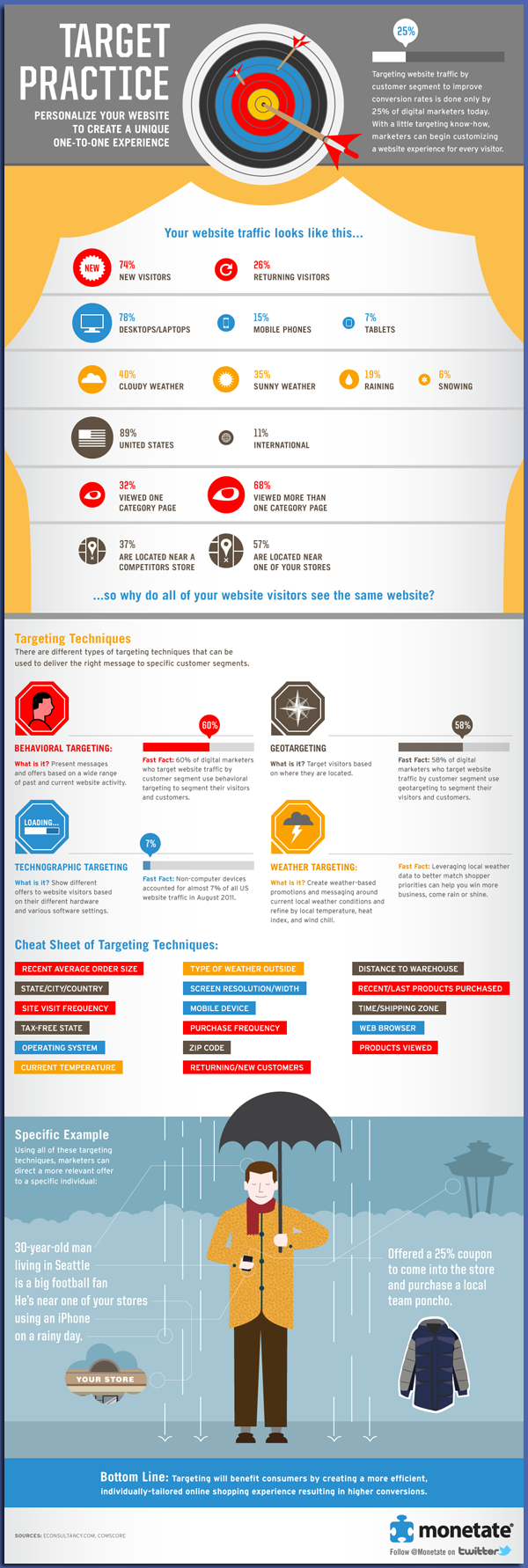At Predictive Response we believe the primary goal of your marketing team should be to find the ideal customer (or donor) – so that you can design your product, pricing, and promotions to meet the needs of that customer. In the digital age, with the ability to collect large amounts of data and review analytics, it is becoming increasingly easy to personalize promotions and products to very specific niches. Despite the increased potential of targeted marketing, only 25% of marketers are personalizing their website content by customer segment. With analytics you can collect all kinds of information that may be relevant to your company including: the geographic location of your website visitors, the pages they are viewing, and the products they are buying. Check out the infographic below to learn about other types of information collected by analytics software. 
Depending on the nature of your business this information can be used to target messaging and promotions to specific customers and improve your conversion rates. It may help to segment your customers using data in one of these four categories:
Behavioral Targeting:
This is the most common type of targeted marketing, that almost any business can use. All you have to do is use an analytics program to collect data about the behavior of your customers on your website, with your email campaigns, (or with your business in general). For instance you may want to offer specific product information, content, or promotions based on their last purchase, the pages viewed on your website, emails opened, or the frequency that they visited your site. This type of information will also help you determine which leads are most “qualified” and where your sales team should be focusing their efforts.
GEO-Targeting:
This is the second most common type of targeted marketing where the location of your customer or lead is tracked through their IP address. This type of marketing is most relevant to brick and mortar stores or other business that are limited by a geographic area. This is also helpful if you have many stores, in many different cities. With geo-targeting you can determine the location of your lead or customer and offer them promotions for products or services offered in your nearby stores. You can also use geo-targeting to manage costs by determining the distance of your customer to different distribution warehouses or by segmenting them by their shipping zones or the tax rates of their state.
Technographic Targeting:
A newer type of targeted marketing is technogrpahic where your company uses data about the type of hardware, software, or browser your customer is using to create specialized messaging or promotions. For instance if you are a software company creating applications for iphones, than can only be run on iOS, it is very helpful to know which of your website visitors are browsing your site using their iphones. Also, generally knowing the percent of your traffic that is viewing your site on a mobile device will help your company decide how to manage your web development and whether to invest in a responsive website.
Weather Targeting:
This is another type of location based targeting that benefits certain types of seasonal businesses. For instance, companies that specialize in snow gear, snow sports, or weather management services can benefit from targeting customers that live in cities currently experiencing a snow storm. Alternately, companies that sell air conditioning units, fans, swim wear, or sunblock can benefit from knowing which customers live in cities that are experiencing a heat wave. Contact us today to learn more about targeted marketing and optimizing your digital marketing strategy!
